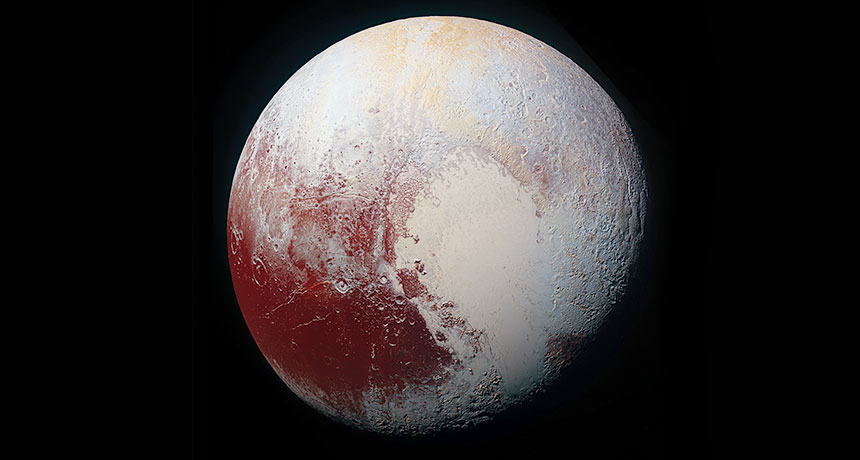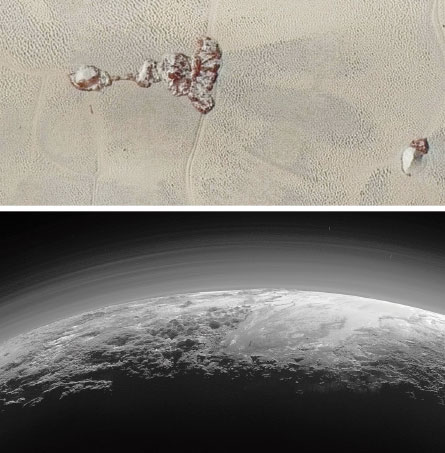Year in review: Pluto unveiled as a world like no other
Dwarf planet wows with unexpected landscapes and blue skies

WORLD LIKE NO OTHER Long out of reach, Pluto came into focus in 2015 with the New Horizons mission.
JHU-APL, NASA, SwRI
- More than 2 years ago
Mountains of water ice tower thousands of meters over fields of frozen nitrogen and methane. Glaciers etched with channels hint at heat bubbling up from below. A patchwork of new and old terrains — some laid down in the last 10 million years, some as old as the planet itself — blanket the ground. And what appear to be two ice volcanoes punch through the terrain.
The alien landscapes of Pluto and its moons dazzled scientists and nonscientists alike this year. More than eight decades after its discovery, Pluto became much more than a nondescript point of light. It’s a dynamic, complex world unlike any other orbiting the sun (SN: 12/12/15, p. 10).
“Seeing a new world for the first time, I mean that’s huge,” says Cathy Olkin, a planetary scientist at the Southwest Research Institute in Boulder, Colo., and a deputy project scientist on the New Horizons mission. “It’s amazing to look at this world and realize I’ve been staring at it for years through a telescope and all that detail was there.”
Pluto’s transformation came courtesy of a robotic spacecraft roughly the size of a grand piano (SN: 6/27/15, p. 16). After traveling for nine and a half years across nearly 5 billion kilometers — roughly the distance to the moon and back 6,700 times — New Horizons made its closest approach to Pluto on July 14, just 12,500 kilometers from its surface, close enough to see features the size of New York’s Central Park.

As the spacecraft raced toward this remote outpost at roughly 50,000 kilometers per hour, one thing became abundantly clear: People still love Pluto. On flyby day, the world waited anxiously for news from the Johns Hopkins University Applied Physics Laboratory in Laurel, Md., where hundreds of scientists and journalists had gathered for the planet party of the decade (SN Online: 7/15/15). Pictures of Pluto and its largest moon, Charon, soon graced television screens, newspapers and magazines across the globe. The lonely underdog, kicked out of the planet club in 2006, became a celebrity. Planet or not, “Pluto is the star of the solar system,” says mission leader Alan Stern.
As soon as the spacecraft beamed back its first detailed images, it was clear that Pluto had reinvented itself many times during its 4.6-billion-year lifetime (SN: 8/8/15, p. 6). Mountains, ice flows and a region devoid of craters implied that Pluto was geologically alive. The surfaces of some moons in the outer solar system have been reworked as well, but unlike Pluto, those satellites are under the influence of gravity from a host planet. Tiny Pluto, far from any other world, mysteriously changes itself.
So much about Pluto is alien to Earthlings. On a world where a warm day is about −220° Celsius, the bedrock is made of hardened water ice. But there’s also something oddly familiar: Pluto has blue skies. Layers of haze stack on top of one another to build a tenuous atmosphere (SN Online: 10/15/15). The haze scatters sunlight into the nightside, teasing researchers with glimpses of odd landforms faintly illuminated in Pluto’s twilight. Within that atmosphere, ice moves back and forth across hemispheres through the interminable seasons. It appears to snow on Pluto.

Even the five moons held a few surprises. Dramatic canyons slash across Charon, whose dark polar cap has no parallel. Styx, Nix, Kerberos and Hydra tumble and spin like a collection of chaotic tops, a dance seen nowhere else in the solar system (SN: 11/28/15, p. 14). And researchers have uncovered all these riches after the spacecraft has transmitted only 20 percent of its data. Complex composition data and images with even more detail have yet to be downloaded. “Who knows what’s going to show up in that 80 percent,” says Mark Showalter, a planetary scientist at the SETI Institute in Mountain View, Calif., who discovered Kerberos and Styx while New Horizons was en route.
Such diversity suggests that even more strangeness awaits in the outer solar system, where the age of discovery is not over. NASA’s Juno spacecraft will arrive at Jupiter in July and plans are under way for a mission to the gas giant’s ice-encrusted moon Europa (SN Online: 6/18/15). In August, NASA tasked engineers at the Jet Propulsion Laboratory in Pasadena, Calif., with figuring out what it would take to return to either Uranus or Neptune, which haven’t been visited since the 1980s.
And then there are the other dwarf planets, such as Sedna and Eris. “It gives me hope for younger people,” says William McKinnon, a planetary scientist at Washington University in St. Louis. “When they want to go out and explore Eris or some other world, they’re going to find even more amazing things.”
New Horizons, meanwhile, is on course for its next stop: 2014 MU69, a 50-kilometer-wide hunk of ice about 1.6 billion kilometers past Pluto (SN Online: 11/5/15). Unlike Pluto, MU69 is probably pristine, an untouched relic from the dawn of the solar system. There, researchers hope to study an example of one of the fundamental building blocks of the planets.
Once MU69 is far behind it, the spacecraft will eventually stop transmitting data. It will leave the confines of the solar system and sail into interstellar space. Long after humans have vanished, New Horizons will continue drifting through the galaxy, a monument to a people who weren’t content to watch those wandering points of light in the sky but reached across billions of kilometers to explore new worlds.
|
SPOTLIGHT ON PLUTO Take a look back at Pluto’s year in the spotlight. C. Crockett, H. Thompson, C. Zabriskie, nemoDaedelus, NASA, JHUAPL, SwRI |







